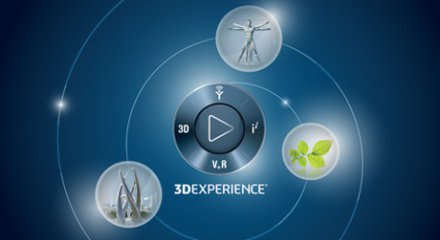Building a New Consumer Experience

Latest News
November 24, 2015
The relationship between society and technology is a closely linked one. Consumers have always used tools, machinery and everyday items to make new products, produce goods and enrich their lives. Through with the advancement of technology, the way society interacts with it has changed to become more individualized, specialized and customized.
At Dassault Systèmes’ 3DEXPERIENCE Forum in Boston on Nov. 16th, attendees learned about “Doing Business in the Age of Experience” and how its portfolio can help engineers create and manage products that are dynamic. “Experiences are becoming the new economic offering,” says Monica Menghini, executive vice president and chief strategy officer at Dassault. Society is using technology that is more responsive and interactive, requiring engineers to use consumer input as a part of design and innovation. With this shift, Dassault is adding tools to its 3DEXPERIENCE platform to support Experience Thinking, which “goes beyond the product and considers usage after it leaves the factory,” Menghini says.
The @Dassault3DS Experience Thinking strategy and framework for innovation. #3DXForum pic.twitter.com/10F9jk1qYw
— Desktop Engineering (@DEeditor) November 16, 2015
This sentiment is particularly resonating with engineers, technologists and analysts studying the Internet of Things. Emerging sensor-equipped products now raise questions about how to use the collected data, creating a software configuration that can support increasingly complex designs and how consumers are using these smart products on a daily basis.
An Age of Product Enchantment
To enhance the user experience, product designers and engineers are now having to consider ways to integrate multiple capabilities into an eye-catching product. This new age of product design is delving into the realm of “enchanted objects,” the main subject of keynoter David Rose’s talk. “Enchanted objects are just ordinary things, just augmented and connected,” he says. Enchantment is one of the focuses of the MIT Media Lab, where Rose is a visiting scientist.
Some of these designs can take inspiration from pop culture and fantasy, but the ultimate goal is to offer users an object that does not immediately appear to have multiple capabilities. “The[se] objects appear to be normal until they’re not.” During his speech, Rose cited an umbrella that would glow in cases of impending rain; similar to Frodo’s sword in “The Lord of the Rings” trilogy.
By augmenting objects, engineers must now consider what functions are most important to the users, all the possible ways a product can be used and the simplest way to convey information. “Our devices can be a lot simpler and our interaction with them can be a lot simpler,” says Rose. Furthermore, easier use and streamlined interfaces will provide more access to data — such as the weather, the stock market or even when the next bus is near. “Making data public will make it more persuasive,” Rose says. With more persuasive, consumer-friendly data, it is possible engineers could find use of data collected from their smart devices in the field.
From an aesthetic viewpoint, Rose notes that “if some social robots [or technology] is too human-like, we feel they threaten our humanity.” Consumers also want customizability to their wearable products, adding another layer of product complexity. (Editor’s Note: For more, read “Wearables Put Your Design on Your Sleeve”).
Yet even with the added complexity of smart devices, Rose believes they are becoming the new standard in product design. “I think that any product company that is not prototyping the connected version of their product is way behind. And almost any product company is experimenting with all different kinds of services [and functions] associated with [their offerings],” Rose says.
A New Shift in Industry
Just as product design is entering a new paradigm, manufacturing and industrial equipment is adapting as well. According to Philippe Bartissol, vice president of Industry Equipment, more equipment companies are facing challenges such as systems engineering, digital manufacturing and product service after it has left the production line. “Across the last three years, we have boiled [product manufacturing] down to six main challenges: to collaborate globally; acceleration of time to market; emergence of systems engineering discipline; how to cope with diversity; behavior simulation; and after-sale service,” says Bartissol.
Bartissol feels that a lot of companies are becoming involved within IoT and Industrie 4.0 without creating the proper workflow first. To properly support the new technology, more investment should go into services and digital manufacturing. By doing so, industrial equipment companies will be able to maintain records and service equipment more easily. He also notes that simulation capabilities will become more necessary with systems-based products; something that isn’t quite developed yet for siloed design workflows.
To help address some of these challenges, Dassault is adding more robust capabilities to its current 3DEXPERIENCE portfolio. “On our platform, we are offering RFID, electrical schematics, pneumatic schematic and hydraulic schematics in one place, letting users do 2D and 3D modeling in a way that tears down the barrier between electrical and mechanical engineering. Currently, these engineers work in parallel and they share data in the meeting room,” says Bartissol. Now, with the ability to unify multiple schematics, engineers can define one source for schematic information and maintenance needs.
It’s no secret we’re entering a new era of engineering — smart products are producing a ripple effect throughout product design, manufacturing and even data usage. This new age is having industry reconsider the engineer/consumer relationship and what tools are going to be most useful to produce the latest technology.
Below you’ll find a video of the Disruptive Technologies panel from the event.
Subscribe to our FREE magazine, FREE email newsletters or both!
Latest News
About the Author
Jess Lulka is a former associate editor for Digital Engineering. Contact her via [email protected].
Follow DE





